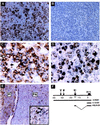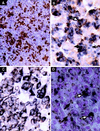DNase I-hypersensitive sites I and II of the human growth hormone locus control region are a major developmental activator of somatotrope gene expression
- PMID: 9724759
- PMCID: PMC27950
- DOI: 10.1073/pnas.95.18.10655
DNase I-hypersensitive sites I and II of the human growth hormone locus control region are a major developmental activator of somatotrope gene expression
Abstract
High-level expression of the human growth hormone (hGH) gene is limited to somatotrope and lactosomatotrope cells of the anterior pituitary. We previously identified a locus control region (LCR) for the hGH gene composed of four tissue-specific DNase I-hypersensitive sites (HS) located between -14.6 kb and -32 kb 5' to the hGH transcription start site that is responsible for establishing a physiologically regulated chromatin domain for hGH transgene expression in mouse pituitary. In the present study we demonstrated that the LCR mediates somatotrope and lactosomatotrope restriction on an otherwise weakly and diffusely expressed hGH transgene. The subregion of the LCR containing the two pituitary-specific HS, HSI and HSII (-14.6 to -16.2 kb relative to the hGH promoter and denoted HSI,II), was found to be sufficient for mediating somatotrope and lactosomatotrope restriction, for appropriately timed induction of hGH transgene expression between embryonic days 15.5 and 16.5, and for selective extinction of hGH expression in mature lactotropes. When studied by cell transfection, the HSI,II fragment selectively enhanced transcription in a presomatotrope-derived cell line, although at levels (2- to 3-fold) well below that seen in vivo. The LCR activity of the HSI,II element was therefore localized by scoring transgene expression in fetal founder pituitaries at embryonic day 18.5. The data from these studies indicated that a 404-bp segment of the HSI,II region encodes a critical subset of LCR functions, including the establishment of a productive chromatin environment, cell-specific restriction and enhancement of expression, and appropriately timed induction of the hGH transgene during embryonic development.
Figures





References
Publication types
MeSH terms
Substances
Associated data
- Actions
Grants and funding
LinkOut - more resources
Full Text Sources

